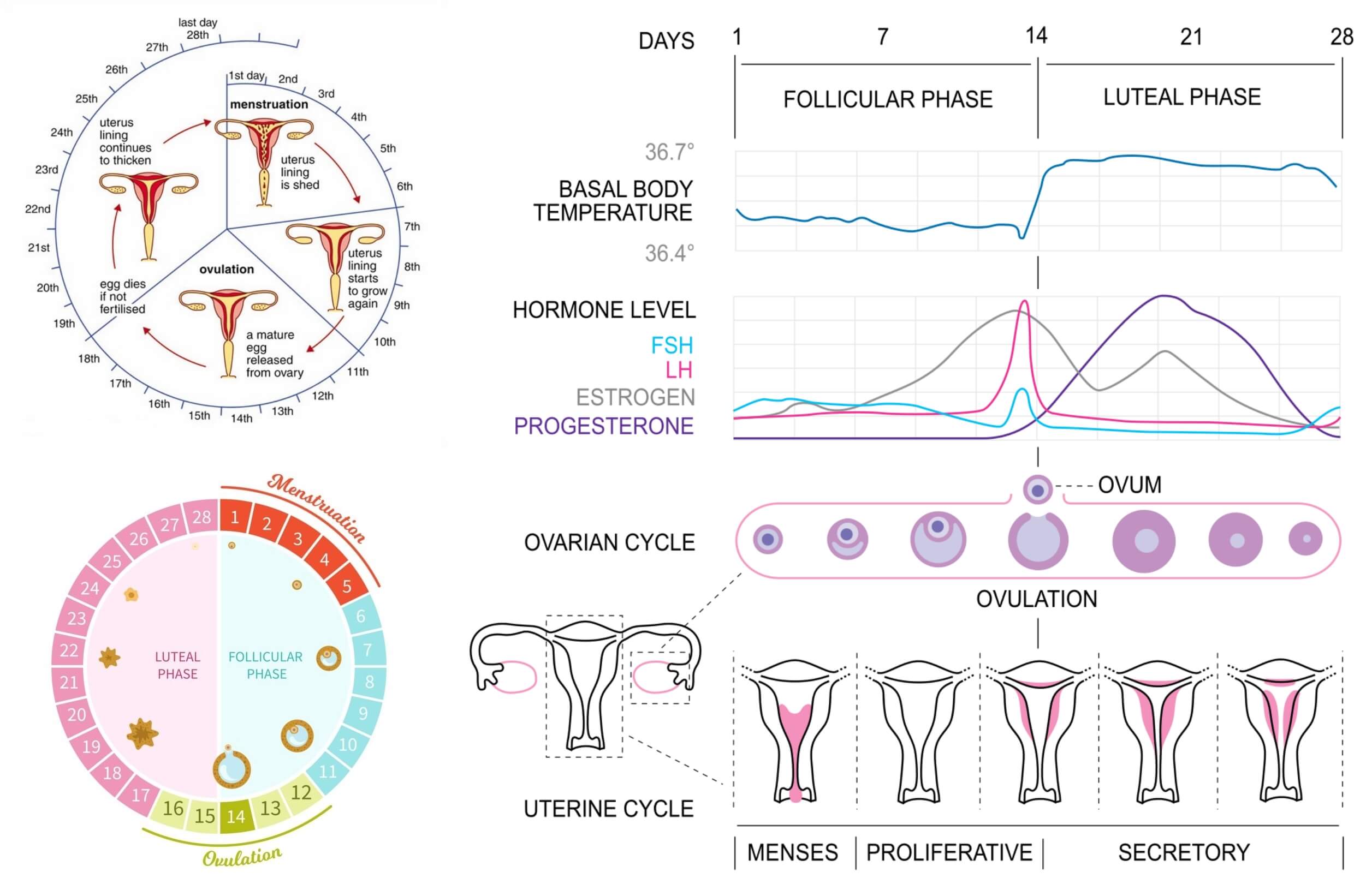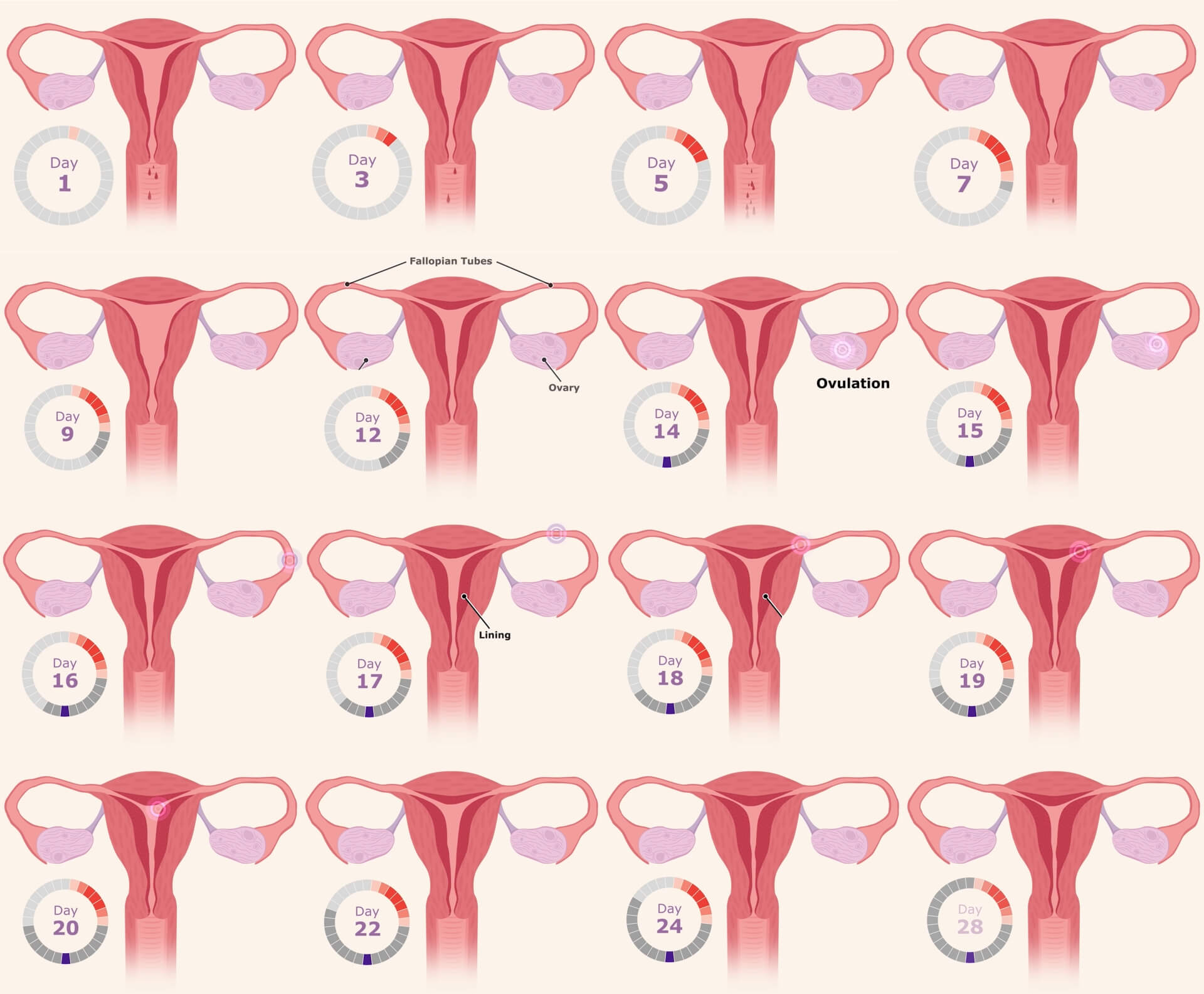Either we are men or women, generally we are not having proper knowledge regarding menstruation cycle of women. What to do or don’t in this Period? why its occur every month? what are the symptoms occur in menstruation? what are the safest days of intercourse to avoid pregnancy? all of your confusion will be clear here today, we will explain everything regarding Menstruation (monthly periods) in simple way. So, let’s get start.
CONTENT INDEX
What is Menstruation?
In Female reproductive system, Menstruation is a discharge from the lining of a woman’s uterus (commonly called the uterus) once a month. Menstruation is also called menstrual period or cycle. Menstrual blood (Menstrual fluid) is a part of blood and also a part of uterine tissue, which flows out of the body from the uterus through the cervix and through the vagina.
What is a Menstruation Cycle?
The menstrual cycle is a term used to describe the series of events that occur in a woman’s body every month when she is about to give birth. It is believed that menstruation starts on the first day of menstruation cycle, the average period of cycle is 28 days. However, the length of the cycle varies from 21 to about 35 days, and the phase of the menstrual cycle is determined by the increase or decrease of chemicals called hormones in the body. The pituitary gland and the ovaries of the female reproductive system produce and secrete specific hormones (Follicle stimulating hormone (FSH), luteinizing hormone (LH), Estrogen, Progesterone) at specific times of the menstrual cycle, causing the reproductive system to respond in specific ways.
Process of Menstrual Cycle Explained as Follows:
Period of menstruation: During this period, which usually lasts from 1 to 5 days, the lining of the uterus protrudes from the vagina when not pregnant. Most women bleed for 3-5 days, but a period of 2-7 days is still normal.
Follicular phase: Estrogen increases and the lining of the uterus (called the endometrium) grows and thickens. Another hormone, follicle-stimulating hormone (FSH), also stimulates follicle development.
Ovulation: On days 10-14, one of the growing follicles produces a full ovulation (egg). This phase occurs around day 14th of a 28-day menstrual cycle. When another hormone (luteinizing hormone) rises suddenly, and the ovaries ovulate. This phenomenon is called ovulation.
Luteal phase: This phase lasts about 15 to 28 days. After the egg is released from the ovary, it begins to travel through the fallopian tubes to the uterus. High levels of progesterone prepare the endometrium for conception. When the egg is fertilized with sperm and attached to the wall of the uterus, the woman becomes pregnant. When pregnancy does not occur, estrogen and progesterone levels drop, and the thick lining of the uterus during menstruation disappears.
At what Age does Menstruation typically Begin?
The average menstrual period start for girls is 12 years. However, girls only start menstruating when they are 8 or 16 years old. Menstruation stops during menopause, which occurs around age of 51. During menopause, women stop producing eggs (not eating more). Menopause is defined as a year without menstruation, after which a woman cannot become pregnant.
What are the Signs and Symptoms of Menstruation? and How to Reduce these?
Mood swings, Crankiness, Anxiety, Tiredness, Food cravings, Pimples, Bloating, Backaches, Sore breast, Trouble sleeping, Cravings, Stomach and Back cramps, Gas, Chest pain, Acne, Moodiness etc.
To Reduce
Cravings: Eat a balanced diet rich in fresh fruits and vegetables.
Gas and Bloating: Reduce salt in your diet.
Stress and anxiety: Avoid caffeine and exercise.
Use a warmer, Acetaminophen (Tylenol or brand name), Ibuprofen (brand Advil, Motrin), Naproxen (Alive brand), or store- bought for back, head, or chest pain relief.
What is PMS (premenstrual syndrome)?
Premenstrual syndrome (PMS) occurs when a woman feels uncomfortable (irregular) before or during menstruation. It usually worsens 4 days before menstruation. Menstruation usually stops a few days after menstruation begins.
Why is Menstruation important for a Woman?
As a woman, the menstrual cycle is the body’s way of secreting tissue that it no longer needs. Your body prepares for pregnancy every month. The endometrium thickens to prepare the fertilized egg for fertilization. The fertilized egg is released and becomes trapped in the wall of the uterus.
If the egg is not fertilized, the body does not need a thick uterine wall, so the egg ruptures and eventually disappears with blood from the vagina. This is your process and when it’s done, the process will start again.
What are the Safest days to Avoid Pregnancy?
Menstruation begins on the first day of a cycle and continues until the first day of the next cycle. Fertility at the time of ovulation (when an egg is released from the ovary), usually between the 12th to 14th days of the next cycle. This is the time when you are most likely to get pregnant.
Safest days to make love without risk (avoid pregnancy) are 1 to 11 days and 19 to 28 days from starting of the periods.
There is very less chance (safest days) to become pregnant immediately after your menstrual period is over up to next 5 days. Although it may also happen a chances of pregnancy in it, because It is also important to remember that Sperm can remain in the women body for up to 7 days after intercourse (Sex). This means that if you ovulate early, and unwillingly you can get pregnant right after your period, especially if your period is naturally short.
Finally, If you want to avoid pregnancy without taking any kind of risk, then you should always use birth control (condoms) during sex. This is the safest and better option to avoid pregnancy.
How do you know if you are Ovulating?
Ovulation is when an egg is released from one of your ovaries. If you want to exercise during ovulation, you can use the following:
Length of the menstrual cycle: Ovulation usually occurs about 10 to 16 days before menstruations. So, how to know that your menstrual period has started? If your cervical mucus circulate on a regular basis, you may be able to determine when you may ovulate – you may notice that the mucus is wetter, clearer, and slippery before and after ovulation.
Your body Temperature: There is slightly increase the body temperature after ovulation, you can use a thermometer to detect the ovulation
Prediction Kit: hormone levels increase before and after ovulation, which can be detected with an ovulation prediction kit that measures the level of hormones in the urine.
These methods are probably the most accurate. Some women may experience other symptoms during ovulation, such as breast tenderness, abdominal distension, and mild stomach pain, but these are not reliable methods for predicting ovulation.
Is a 40days Cycle Normal?
The average cycle is 28 days, but between 21 and 45 days is considered normal. The difference is 24 days. During the first year or two after menstruation, women have long cycles that do not begin at the same time each month.
What is a Menstrual Cup?
Menstrual cups are reusable women’s health products. This is a small, flexible, funnel-shaped rubber or silicone cup inserted inside the vagina to collect menstrual fluid that contains more blood than any other method. the cup can be worn for up to 12 hours. Reusable eyewear brands available include Keeper Cups, Moon Cups, Lunate Menstrual Cups, Day Cups, Lina Cups and Lily Cups. As with menstrual cups, there are many disposable menstrual cups on the market.
How to Insert and Remove a Menstrual Cup:
Firstly you should to know is the size you need. Most menstrual cup brands sell smaller and larger versions. To determine the correct size for your menstrual cup,
Consider the following: Cervical length, high blood flow, flexibility immediately after childbirth, and usually menstrual cups are small. Its Recommended for women under the age of 30. A large size is often recommended for women over 30 who have had a normal childbirth or have had a long menstrual period. However, applying “lubricating oil” to the cup simplifies the process. Lubricate the rim with water or water-based lubricant before installing the cup. Just pour it into a wet menstrual cup. If you can put a tampon in your menstrual cup, it is relatively easy to insert.
To use the cup, follow these steps:
(1) Apply a water or water-based base.
(2) wash your hands thoroughly, and insert your index and thumb into your vagina.
(3) Gently pull down on the cup’s spout and press down to release the seal and pull the cup to remove.
(4) After removing the cup, dispose of it in the sink or toilet.
(5) Cleaned before entering the vagina again.
(6) The cup should be emptied at least twice a day.
Reusable menstrual cups are durable and can last 6 to 10 years if properly cared for. Remove and discard disposable cups.
Poonam chhapola









